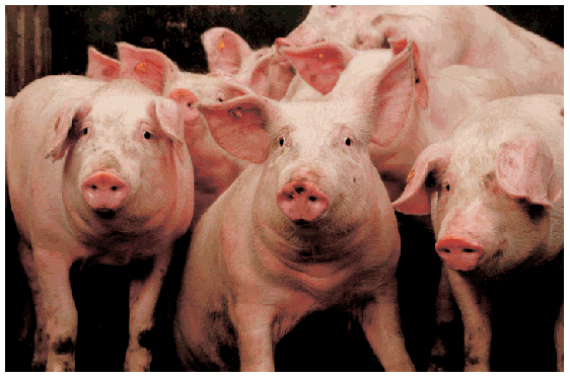Until five years ago, castrating male pigs to prevent boar taint was standard procedure. But for the sake of animal welfare it is now compulsory to anaesthetize the animals before castration and from 2015, castration will be banned. This poses a problem for meat suppliers. Boar taint occurs in the meat of about four percent of the boars, but can only be detected once the meat is under the grill. So how can the ‘stinkers’ be picked out?
Boar taint is by no means a straightforward problem, say Wageningen researchers Han Mulder and Bennie van der Fels. European colleagues are trying to isolate the smell from two chemical components: the male sex pheromone androstenone and skatole, a waste product found in a pig’s intestines. Boars with large amounts of androstenone and skatole in their fat give off boar taint. At least, these substances account for 50 to 65 percent of the cases of boar taint. ‘So it is not 100 percent; there seems to be something else involved’, says Mulder. For this reason, there is no conclusive chemical detection method for boar taint.
So it is necessary to resort to the human nose. But is that nose good enough to pick out that strange odour? To find out, Mulder set up a Human Nose Scoring System. With the help of a soldering iron, a panel assessed a total of more than 6,500 specimens of saliva for boar taint on a scale of 0 to 4. A score of 3 meant a strange smell, and a 4 meant the smell was downright unpleasant. Once the panel had given their scores, Mulder used a statistical programme to check whether they had given the right specimens a 3 or a 4.
The results showed that the average nose failed to pick up specimens that did produce boar taint in 4 percent of cases. Among the specimens that scored a 3, as many as 25 percent of the scores were a false negative. Not good enough, then. But if you give three panel members the same cut of pork to assess and reject all the meat with an average score over 2.5, then the panel detects all the meat with boar taint. Stricter selection for sensitivity to boar taint and better training for the panel members could lead to more precise assessments, claim the researchers. They are still working on validating their test.
Breeding organization Topigs has already benefitted from the results. Mulder linked the results from the smell panel to the pigs’ paternal lineage and noticed that boar taint is largely genetically determined. Topigs now has boars available for pork production in which the chance of boar taint has been reduced by 40 percent without negatively affecting any other characteristics. The research is part of a national research programme ‘Beren op de weg’, funded by the livestock, meat and eggs marketing board of the ministry of EL&I.
By no means everyone can distinguish a ‘stinker’ from a normal boar. Smell is a matter of perception. Forty percent of Dutch men and 54 percent of Dutch women are sensitive to boar taint. Women are more sensitive, probably because they are more sensitive to the male sex pheromone androstenone.

